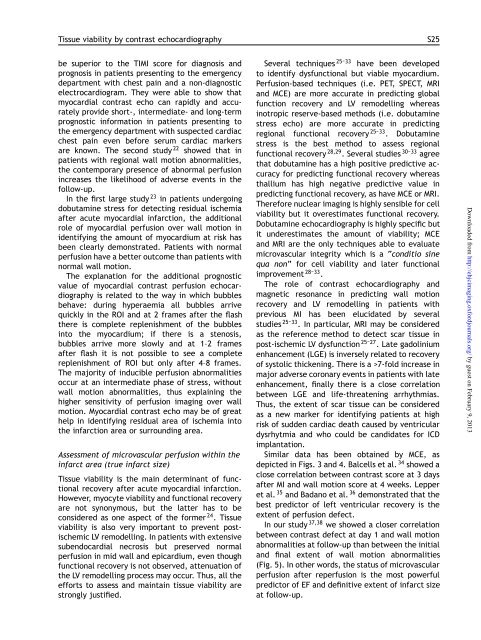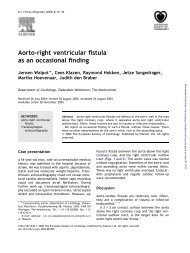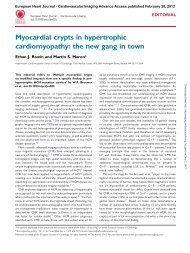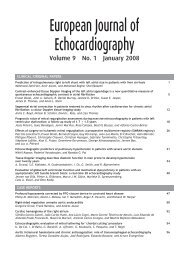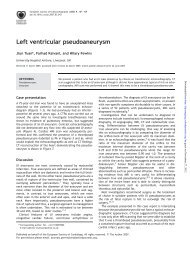Tissue viability by contrast echocardiography - EHJ Cardiovascular ...
Tissue viability by contrast echocardiography - EHJ Cardiovascular ...
Tissue viability by contrast echocardiography - EHJ Cardiovascular ...
You also want an ePaper? Increase the reach of your titles
YUMPU automatically turns print PDFs into web optimized ePapers that Google loves.
<strong>Tissue</strong> <strong>viability</strong> <strong>by</strong> <strong>contrast</strong> <strong>echocardiography</strong> S25<br />
be superior to the TIMI score for diagnosis and<br />
prognosis in patients presenting to the emergency<br />
department with chest pain and a non-diagnostic<br />
electrocardiogram. They were able to show that<br />
myocardial <strong>contrast</strong> echo can rapidly and accurately<br />
provide short-, intermediate- and long-term<br />
prognostic information in patients presenting to<br />
the emergency department with suspected cardiac<br />
chest pain even before serum cardiac markers<br />
are known. The second study 22 showed that in<br />
patients with regional wall motion abnormalities,<br />
the contemporary presence of abnormal perfusion<br />
increases the likelihood of adverse events in the<br />
follow-up.<br />
In the first large study 23 in patients undergoing<br />
dobutamine stress for detecting residual ischemia<br />
after acute myocardial infarction, the additional<br />
role of myocardial perfusion over wall motion in<br />
identifying the amount of myocardium at risk has<br />
been clearly demonstrated. Patients with normal<br />
perfusion have a better outcome than patients with<br />
normal wall motion.<br />
The explanation for the additional prognostic<br />
value of myocardial <strong>contrast</strong> perfusion <strong>echocardiography</strong><br />
is related to the way in which bubbles<br />
behave: during hyperaemia all bubbles arrive<br />
quickly in the ROI and at 2 frames after the flash<br />
there is complete replenishment of the bubbles<br />
into the myocardium; if there is a stenosis,<br />
bubbles arrive more slowly and at 1–2 frames<br />
after flash it is not possible to see a complete<br />
replenishment of ROI but only after 4–8 frames.<br />
The majority of inducible perfusion abnormalities<br />
occur at an intermediate phase of stress, without<br />
wall motion abnormalities, thus explaining the<br />
higher sensitivity of perfusion imaging over wall<br />
motion. Myocardial <strong>contrast</strong> echo may be of great<br />
help in identifying residual area of ischemia into<br />
the infarction area or surrounding area.<br />
Assessment of microvascular perfusion within the<br />
infarct area (true infarct size)<br />
<strong>Tissue</strong> <strong>viability</strong> is the main determinant of functional<br />
recovery after acute myocardial infarction.<br />
However, myocyte <strong>viability</strong> and functional recovery<br />
are not synonymous, but the latter has to be<br />
considered as one aspect of the former 24 . <strong>Tissue</strong><br />
<strong>viability</strong> is also very important to prevent postischemic<br />
LV remodelling. In patients with extensive<br />
subendocardial necrosis but preserved normal<br />
perfusion in mid wall and epicardium, even though<br />
functional recovery is not observed, attenuation of<br />
the LV remodelling process may occur. Thus, all the<br />
efforts to assess and maintain tissue <strong>viability</strong> are<br />
strongly justified.<br />
Several techniques 25–33 have been developed<br />
to identify dysfunctional but viable myocardium.<br />
Perfusion-based techniques (i.e. PET, SPECT, MRI<br />
and MCE) are more accurate in predicting global<br />
function recovery and LV remodelling whereas<br />
inotropic reserve-based methods (i.e. dobutamine<br />
stress echo) are more accurate in predicting<br />
regional functional recovery 25–33 . Dobutamine<br />
stress is the best method to assess regional<br />
functional recovery 28,29 . Several studies 30–33 agree<br />
that dobutamine has a high positive predictive accuracy<br />
for predicting functional recovery whereas<br />
thallium has high negative predictive value in<br />
predicting functional recovery, as have MCE or MRI.<br />
Therefore nuclear imaging is highly sensible for cell<br />
<strong>viability</strong> but it overestimates functional recovery.<br />
Dobutamine <strong>echocardiography</strong> is highly specific but<br />
it underestimates the amount of <strong>viability</strong>; MCE<br />
and MRI are the only techniques able to evaluate<br />
microvascular integrity which is a “conditio sine<br />
qua non” for cell <strong>viability</strong> and later functional<br />
improvement 28–33 .<br />
The role of <strong>contrast</strong> <strong>echocardiography</strong> and<br />
magnetic resonance in predicting wall motion<br />
recovery and LV remodelling in patients with<br />
previous MI has been elucidated <strong>by</strong> several<br />
studies 25–33 . In particular, MRI may be considered<br />
as the reference method to detect scar tissue in<br />
post-ischemic LV dysfunction 25–27 . Late gadolinium<br />
enhancement (LGE) is inversely related to recovery<br />
of systolic thickening. There is a >7-fold increase in<br />
major adverse coronary events in patients with late<br />
enhancement, finally there is a close correlation<br />
between LGE and life-threatening arrhythmias.<br />
Thus, the extent of scar tissue can be considered<br />
as a new marker for identifying patients at high<br />
risk of sudden cardiac death caused <strong>by</strong> ventricular<br />
dysrhytmia and who could be candidates for ICD<br />
implantation.<br />
Similar data has been obtained <strong>by</strong> MCE, as<br />
depicted in Figs. 3 and 4. Balcells et al. 34 showed a<br />
close correlation between <strong>contrast</strong> score at 3 days<br />
after MI and wall motion score at 4 weeks. Lepper<br />
et al. 35 and Badano et al. 36 demonstrated that the<br />
best predictor of left ventricular recovery is the<br />
extent of perfusion defect.<br />
In our study 37,38 we showed a closer correlation<br />
between <strong>contrast</strong> defect at day 1 and wall motion<br />
abnormalities at follow-up than between the initial<br />
and final extent of wall motion abnormalities<br />
(Fig. 5). In other words, the status of microvascular<br />
perfusion after reperfusion is the most powerful<br />
predictor of EF and definitive extent of infarct size<br />
at follow-up.<br />
Downloaded from<br />
http://ehjcimaging.oxfordjournals.org/ <strong>by</strong> guest on February 9, 2013


